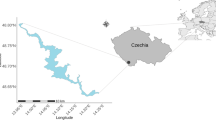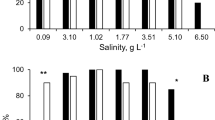Abstract
Seasonal and long-term variations in the body size of planktonic copepods were studied in the northern Baltic Sea. The influence of temperature, salinity and phytoplankton concentration to the body size of Eurytemora affinis, Acartia bifilosa and Limnocalanus macrurus (Calanoida) was examined at three sea areas, differing in their hydrographical and trophic conditions (an archipelago area and an enclosed bay on the SW coast of Finland in 1992 and at an open sea station in the Gulf of Bothnia in 1991). There was an inverse relationship between copepod body length and temperature, while there was a direct effect of phytoplankton concentration. According to multiple regression analysis, the relative importance of these factors varied according to species, developmental stage and study area. In the archipelago area, copepod body size was mainly determined by temperature, while in the open Gulf of Bothnia, phytoplankton concentration was usually more important. Interannual variation in the summer body length of E. affinis and A. bifilosa was examined using samples collected over 18 years (1967 to 1984) in the archipelago area. In this analysis, the inverse relationship between water temperature and copepod body size disappeared; in E. affinis the average female length correlated positively with summer temperature. We suggest that the length and timing of the study period greatly influence the investigator's view of the factors regulating copepod body size.
Similar content being viewed by others
References
Anonymous (1993) Meteorological yearbook of Finland 1991. Finnish Meteorological Institute, Helsinki
Ban S (1994) Effect of temperature and food concentration on post-embryonic development, egg production and adult body size of calanoid copepod Eurytemora affinis. J Plankton Res 16: 721–735
Berggreen U, Hansen B, Kiørboe T (1988) Food size spectra, ingestion and growth of the copepod Acartia tonsa during development: implications for determination of copepod production. Mar Biol 99: 341–352
BMEPC (1988) Baltic Marine Environment Protection Commission, Helsinki Commission 1988. Guidelines for the Baltic Monitoring Programme for the Third Stage; Part D. Biological determinands. Baltic Sea Environment Proceedings 27D, Helsinki
Christou ED, Verriopoulos GC (1993) Length, weigh and condition factor of Acartia clausi (Copepoda) in the eastern Mediterranean. J mar biol Ass UK 73: 343–353
Coker RE (1933) Influence of temperature on size of freshwater copepods (Cyclops). Int Rev ges Hydrobiol 29: 406–436
Comta GW, Anderson GC (1959) The seasonal development of a population of Diaptomus ashlandi Marsh, and related phytoplankton cycles in Lake Washington. Limnol Oceanogr 4: 37–52
Deevey GB (1960) Relative effects of temperature and food on seasonal variations in length of marine copepods in some eastern American and western European waters. Bull Bingham oceanogr Coll 17: 54–85
Durbin EG, Durbin AG, Smayda J, Verity PG (1983) Food limitation of production by adult Acartia tonsa in Narragansett Bay, Rhode Island. Limnol Oceanogr 28: 1199–1213
Escribano R, McLaren IA (1992) Influence of food and temperature on lengths and weights of two marine copepods. J exp mar Biol Ecol 159: 77–88
Evans F (1981) An investigation into the relationship of sea temperature and food supply to the size of the planktonic copepod Temora longicornis Müller in the North Sea. Estuar cstl Shelf Sci 13: 145–158
Flinkman J, Vuorinen I, Aro E (1992) Planktivorous Baltic herring (Clupea harengus) prey selectively on reproducing copepods and cladocerans. Can J Fish aquat Sciences 49: 73–77
Heinle DR, Harris RP Ustach JF, Flemer DA (1977) Detritus as food for estuarine copepods. Mar Biol 40: 341–353
Hirche H-J (1992). Egg production of Eurytemora affinis-effect of k-strategy. Estuar cstl Shelf Sci 35: 395–407
Kankaala P, Johansson S (1986) The influence of individual variation on length-biomass regressions in three crustacean zooplankton species. J Plankton Res 8: 1027–1038
Kiørboe T, Nielsen TG (1994) Regulation of zooplankton biomass and production in a temperate, coastal ecosystem. 1. Copepods. Limnol Oceanogr 39: 493–507
Klein Breteler WCM, Gonzalez SR (1982) Influence of cultivation and food concentration on body length of calanoid copepods. Mar Biol 71: 157–161
Klein Breteler WCM, Schogt N, Gonzalez SR (1990) On the role of food quality in grazing and development of life stages, and genetic change of body size during cultivation of pelagic copepods. J exp mar Biol Ecol 135: 177–189
Kuhlmann D, Fukuhara O, Rosenthal H (1982) Shrinkage and weight loss of marine fish food organisms preserved in formalin. Bull Nansei natn Fish Res Lab 14: 13–18
Kuuppo P (1994) Annual variation in the abundance and size of heterotrophic nanoflagellates on the SW coast of Finland, the Baltic Sea. J Plankton Res 16: 1525–1542
Lehman JT (1988) Ecological principles affecting community structure and secondary production by zooplankton in marine and freshwater environments. Limnol Oceanogr 33: 931–945
Lindquist A (1961) Untersuchungen an Limnocalanus (Copepoda, Calanoida). Inst mar Res Lysekil Ser Biol 13: 1–94
Lock AR, McLaren IA (1970) The effect of varying and constant temperatures on the size of a marine copepod. Limnol Oceanogr 15: 638–640
Malone TC, Chervin MB (1979) The production and fate of phytoplankton size fractions in the plume of the Hudson River, New York Bight. Limnol Oceanogr 24: 683–696
McLaren IA (1963) Effects of temperature on growth of zooplankton, and the adaptive value of vertical migration. J Fish Res Bd Can 20: 685–727
McLaren IA (1965) Some relationships between temperature and egg size, body size, development rate, and fecundity, of the copepod Pseudocalanus. Limnol Oceanogr 10: 528–538
McLaren IA, Sévigny J-M, Corkett CJ (1989) Temperature-dependent development in Pseudocalanus species. Can J Zool 67: 559–564
Niemi Å (1975) Ecology of phytoplankton in the Tvärminne area, SW coast of Finland. II. Primary production and environmental conditions in the archipelago and the sea-zone. Acta bot fenn 105: 1–73
Niemi Å (1978) Ecology of phytoplankton in the Tvärminne area, SW coast of Finland. III. Environmental conditions and primary production in Pojoviken in the 1970s. Acta bot fenn 106: 1–28
Rudstam LG, Hansson S, Johansson S, Larsson U (1992) Dynamics of planktivory in a coastal area of the northern Baltic Sea. Mar Ecol Prog Ser 80: 159–173
Salonen K (1979) A versatile method for rapid and accurate determination of carbon by high temperature combustion. Limnol Oceanogr 24: 177–183
Schnack SB (1982) The structure of the mouth parts of copepods in Kiel Bay. Meeresforsch Rep mar Res 29: 89–101
Stoecker DK, Egloff DA (1987) Predation by Acartia tonsa Dana on planktonic ciliates and rotifers. J exp mar Biol Ecol 110: 53–68
Tanskanen S (1994) Seasonal variability in the individual carbon content of the calanoid copepod Acartia bifilosa from the northern Baltic Sea. In: Ferrari FD, Bradley BP (eds) Ecology and morphology of copepods. Proc. 5th Internat. Conf. on Copepoda, Baltimore, USA, 6–13 June 1993. Hydrobiologia 292/293: 397–404
Vidal J (1980 a) Physioecology of zooplankton. II. Effects of phytoplankton concentration, temperature, and body size on the development and molting rates of Calanus pacificus and Pseudocalanus sp. Mar Biol 56: 135–146
Vidal J (1980 b) Physioecology of zooplankton. I. Effects of phytoplankton concentration, temperature, and body size on the growth rate of Calanus pacificus and Pseudocalanus sp. Mar Biol 56: 111–134
Viitasalo M (1992) Mesozooplankton of the Gulf of Finland and northern Baltic proper. A review of monitoring data. Ophelia 35: 147–168
Warren GJ (1985) Predaceous feeding habits of Limnocalanus macrurus. J Plankton Res 7: 537–552
Warren GJ, Evans MS, Jude DJ, Ayers JC (1986) Seasonal variations in copepod size: effects of temperature, food abundance, and vertebrate predation. J Plankton Res 8: 841–853
Author information
Authors and Affiliations
Rights and permissions
About this article
Cite this article
Viitasalo, M., Koski, M., Pellikka, K. et al. Seasonal and long-term variations in the body size of planktonic copepods in the northern Baltic Sea. Marine Biology 123, 241–250 (1995). https://doi.org/10.1007/BF00353615
Received:
Accepted:
Issue Date:
DOI: https://doi.org/10.1007/BF00353615




